Mornington Crescent and the Corn Laws – two totally unconnected subjects, but there is a tentative connection to the Corn Laws not far from Mornington Crescent underground station which I will get to at the end of today’s post.
The name Mornington Crescent may bring little recognition, apart from a Camden station on the Northern Line, or the name may be instantly familiar from the BBC radio comedy “I’m Sorry I Haven’t A Clue” where it is the name of an invented game which requires the naming of a random set of locations to finally get to Mornington Crescent.
The entrance to Mornington Crescent station on Hampstead Road:
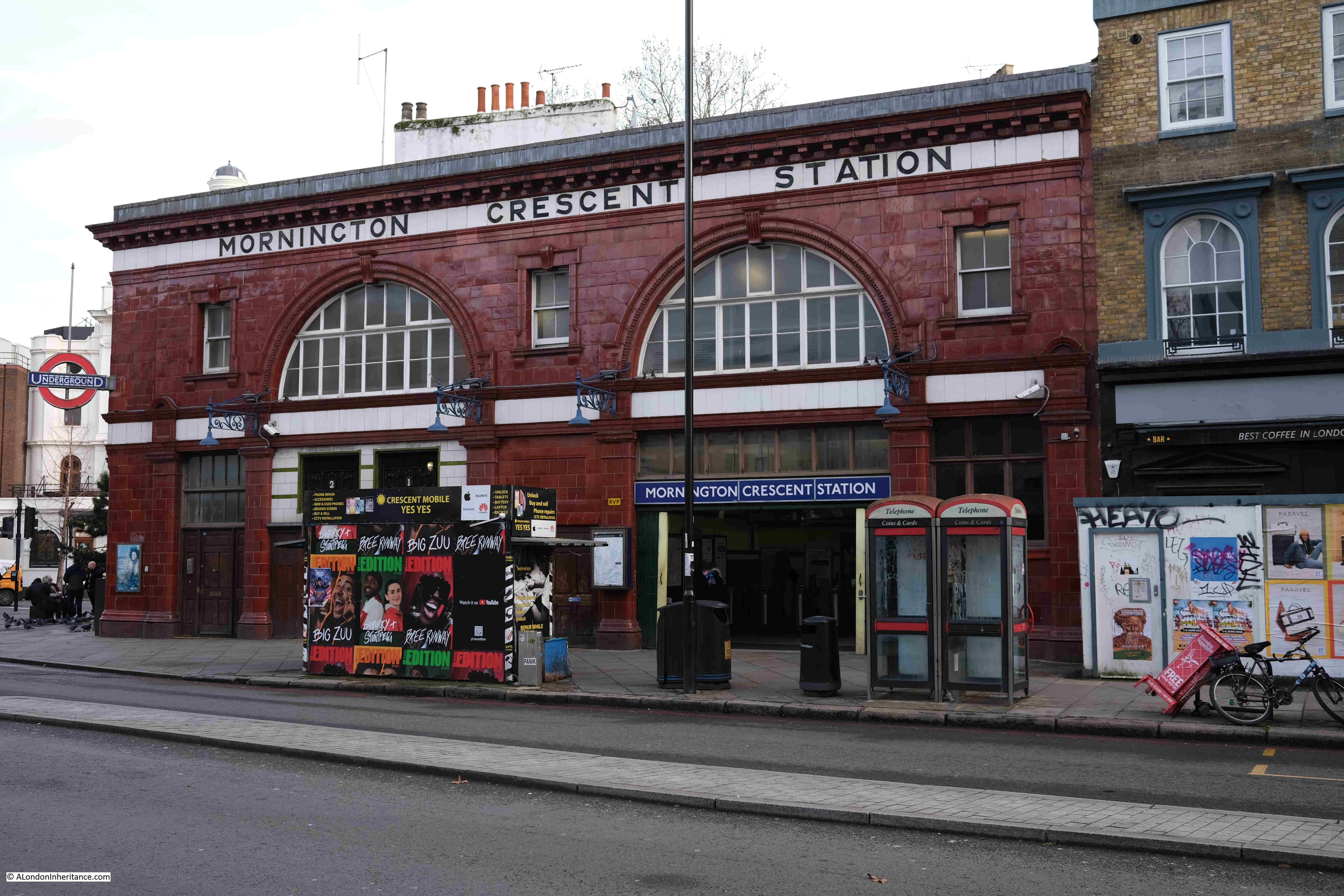
Mornington Crescent station was built as part of the Charing Cross, Euston and Hampstead Railway, and opened on the 22nd of June 1907. The station is one of Leslie Green’s distinctive station designs with the exterior walls covered in red oxblood faience tiles. The station is now on the Northern Line.
The station takes its name from the nearby street of the same name, a street that was once prominent, but is now hidden away behind a rather glorious 1920s factory.
The location of the station is shown by the blue circle in the following map, and the larger red circle shows the area covered in this week’s blog (Map © OpenStreetMap contributors):
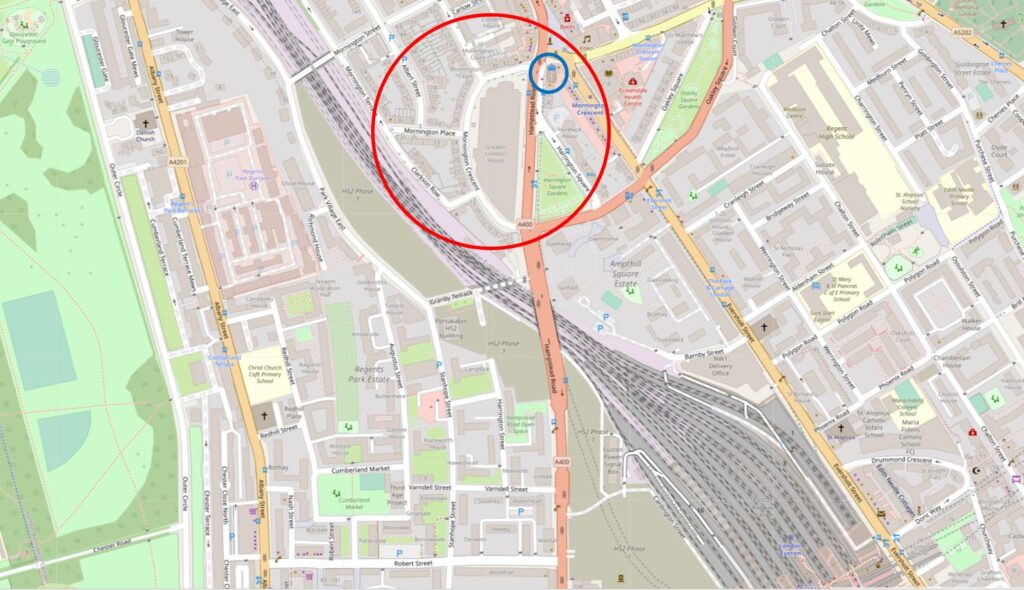
Mornington Crescent (the street, not the station) is the curved, crescent shaped street that starts to the left of the station, curves around a large grey block and then rejoins Hampstead Road. The following extract from the 1894 Ordnance Survey map shows the area in the late 19th century, with Mornington Crescent then looking onto a garden, the larger part to the left of Hampstead Road and a small part to the right (‘Reproduced with the permission of the National Library of Scotland“).:

The large grey block in the map of the area today, and which now occupies the area where the garden was located is the wonderful old Carreras cigarette factory, now offices:

The Carreras brand dates from the early 19th century when the Spanish nobleman Don José Carreras Ferrer started trading cigars in London. The business expanded into other forms of tobacco such as snuff and cigarettes, and became a significant business during the late 19th century.
What really drove the brand’s expansion, and the opening of the Mornington Crescent factory was the transformation of Carreras to a public company in 1903, when a Mr. W. J. Yapp (who had taken over the company from the Carreras family) and Bernhard Baron (of Jewish descent, who was born in what is now Belarus on the Russian border, who had moved to the United States and then to London), became directors of the company.
Whilst in New York, Bernhard Baron had invented a machine that could manufacture cigarettes at a faster rate than existing machines, and in London the Carreras company was the only one that took on the new machines, other tobacco companies preferring to stay with their existing means of production, or machines over which they held monopolies.
By the start of the 1920s, Baron was Chairman of the company and wanted to create a large, modern factory, which would enhance the brand’s reputation for the purity and quality of their cigarettes, and provide a good working environment for the company’s employees.
The result was the new factory on the old gardens between Mornington Crescent and Hampstead Road.
Designed by the architectural practice of Marcus Evelyn Collins and Owen Hyman Collins, along with Arthur George Porri who acted as a consultant, the design of the building was inspired by the archeological finds in Egypt during the 1920s, with the tomb of the Egyptian pharaoh Tutankhamun being discovered in 1922.

The building was one of the first (and I believe the largest at the time) building to use pre-stressed concrete, and also to be fitted with air conditioning and dust extraction equipment.
The innovative construction of the building, and the technologies used to maintain the internal environment were mentioned in all the major news reports that covered the opening of the building on the 3rd of November 1928:
“Carreras new factory at Camden Town, which was opened by Mr. Bernhard Baron, the chairman of the company, constitutes not only the largest reinforced concrete building under one roof in Great Britain, but also that rare thing – the realisation of one man’s dream.
Mr. Baron is a practical idealist. He set out to make cigarettes, he wanted them made in the best way, and in the best conditions. He wanted the people who made them to be happy in their work, it has all come true.
The opening ceremony was as impressive in its simplicity as the new building is in its efficiency and design. Mr. Baron performed it himself, not so much as chairman of the company, but as the father of the three thousand employees who have helped him to achieve success. He said, at the luncheon, that he felt it a great honour to have opened the factory, and that he wanted his employees about him at that moment to share his pleasure. That was why he decided on a simple ceremony, a family celebration, as it were, of the culmination of one stage of his life’s work.
Carreras new building embodies all that is best in factory design. It is well lit, and well ventilated and as healthy as it is possible to make it.
Most important of all, it has been fitted with an air conditioning plant which is the only one of its kind in the British tobacco industry, and which ensures a consistently ideal atmosphere for the manufacture of the perfect cigarette. The air which enters the building is first washed clean with water. It is then adjusted to the required temperature and humidity. Outside, London may be shivering or sweltering, damp or dusty. Inside, every day is a fine day; all weather is fair weather. It is well known that the English climate is the best in the world for the manufacture of tobacco; it can now be said that Carreras climate is the best in England.
The façade of the building, which stretches five hundred and fifty feet along Hampstead Road, is something fresh in London architecture – a conventionalised copy of the Temple of Bubastis, the cat headed goddess of Ancient Egypt.”
I have read several modern references to the opening of the building which include that the Hampstead Road was covered in sand, there were chariot races and Verdi’s opera Aida was performed, however I cannot find these mentioned in any of the news reports from the time that covered the opening of the building. As seen in the above report, the “opening ceremony was as impressive in its simplicity as the new building is in its efficiency and design“.
The opening of the factory was seen as an improvement to the area, although it had resulted in the loss of the open space between Mornington Crescent and Hampstead Road, as newspapers reported that “When the move to save the London squares was first begun, Mornington Crescent was cited as one of London’s losses. It had been acquired by Mr. Bernhard Baron as the site of his new factory. I doubt whether had it been saved we Londoners would have gained anything. Now when you come out of the Tube station, the eyesore of that dirty bit of green, backed by decaying Victorian basement houses is no more. Instead, there is the finest factory in London, an architectural triumph for Mr. Marcus Collins, the culmination of a life’s work for Mr. Baron and a model workplace for his 3,500 employees.”
The Mornington Crescent factory remained in operation until 1959 when Carreras merged with Rothmans, and cigarette production was moved to a factory in the new town of Basildon in Essex.
The building was sold and in 1961 it became office space, with the name of Greater London House, and all the Egyptian decoration was either removed or boxed in.
This would remain the fate of the building until the late 1990s when a new owner refurbished the building and restored the Egyptian decoration that we see today, as close as possible to the original design.
In the following photo of the main entrance to the building, two black cats can be seen on either side of the steps:
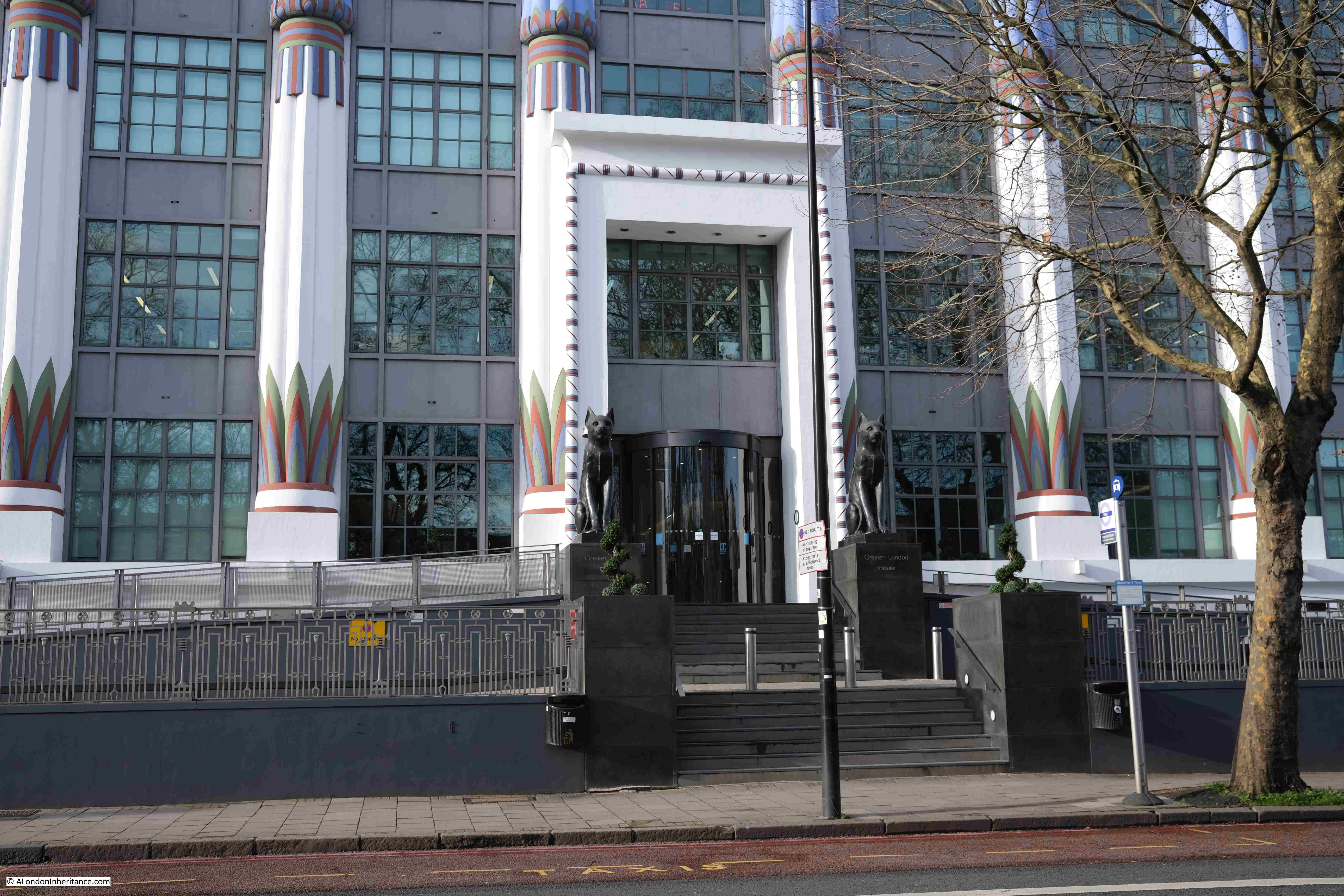
These are not the original cats as following the closure of the factory in 1959, one was transferred to the new factory in Basildon whilst the other was shipped to a Carreras factory in Jamaica.
After walking north along Hampstead Road, through the works for HS2, the restoration of the Carerras building has retained some wonderful 1920s architecture to this part of Camden, however it has almost completely hidden Mornington Crescent, and a walk along this street is my next destination, starting from the northern end, opposite the underground station, where the Lyttleton Arms now stands:
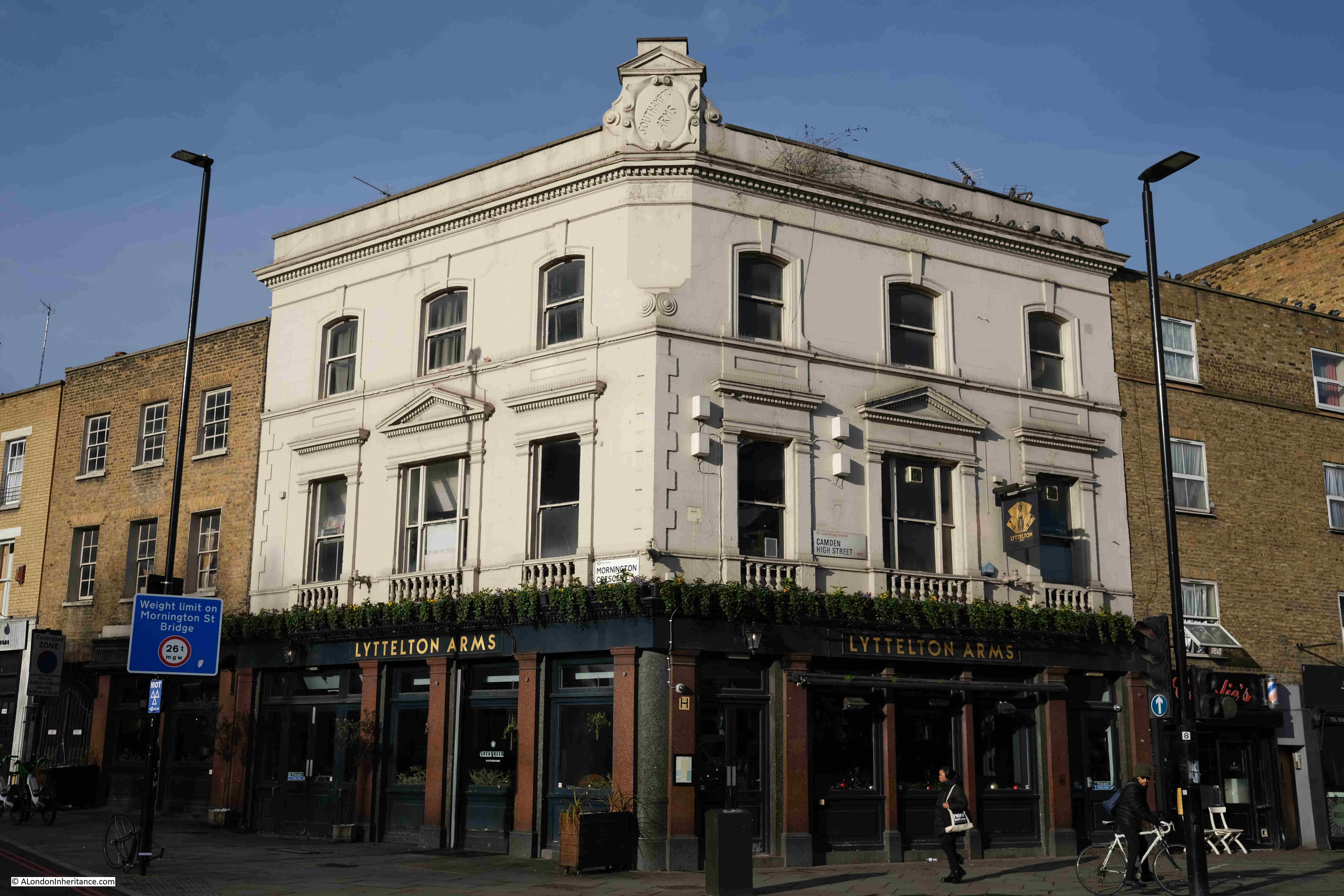
If you look closely at the top corner of the building, you will see the original name of the pub as the Southampton Arms. The pub was renamed the Lyttleton Arms in honour of the jazz musician and radio presenter, Humphrey Lyttleton, who was also the long running host of the radio panel game I’m Sorry I Haven’t a Clue from 1972 until his death in 2008, the show that included the game Mornington Crescent.
During the 1920s, the same decade that the Carerras factory was built, the Southampton Arms, as the pub was called, was one of the centres of conflicts between the gangs who tried to control race course betting, including the Clerkenwell Sabini Brothers and Camden’s George Sage.
The following report from the St. Pancras Gazette on the 6th of October 1922 illustrates one of the incidents:
“RACING MEN’S FEUDS – At Marylebone on Tuesday, Alfred White, Joseph Sabini, George West, Simon Nyberg, Paul Boffa, and Thomas Mack made their eighth appearance on the charges of shooting George Sage and Frederick Gilbert with intent to murder, at Mornington-crescent, Camden Town, on August 19, having loaded revolvers on their possession with intent to endanger life, and riotously assembling.
Helen Sage, wife of one of the prosecutors, said she was talking to her husband outside the Southampton Arms at Camden Town when several taxicabs drove up and a number of men alighted. She then heard a shot, but could not say who fired, as it was dark. The witness admitted that she told the police that West and White fired the shots, but now declared that this statement was untrue.”
Strange that Helen Sage, who was presumably the wife of the shot George Sage declared that her statement was untrue. Possibly some witness tampering or gangs not giving evidence against each other, preferring their own form of justice.
The first section of Mornington Crescent (from the north) is not part of the original, and this will become clear with the architectural style as we walk along the crescent. These later houses are smaller and less impressive than the original part of the crescent:

And after crossing the junction with Arlington Road, we can now see the original terrace of buildings from when Mornington Crescent was laid out:
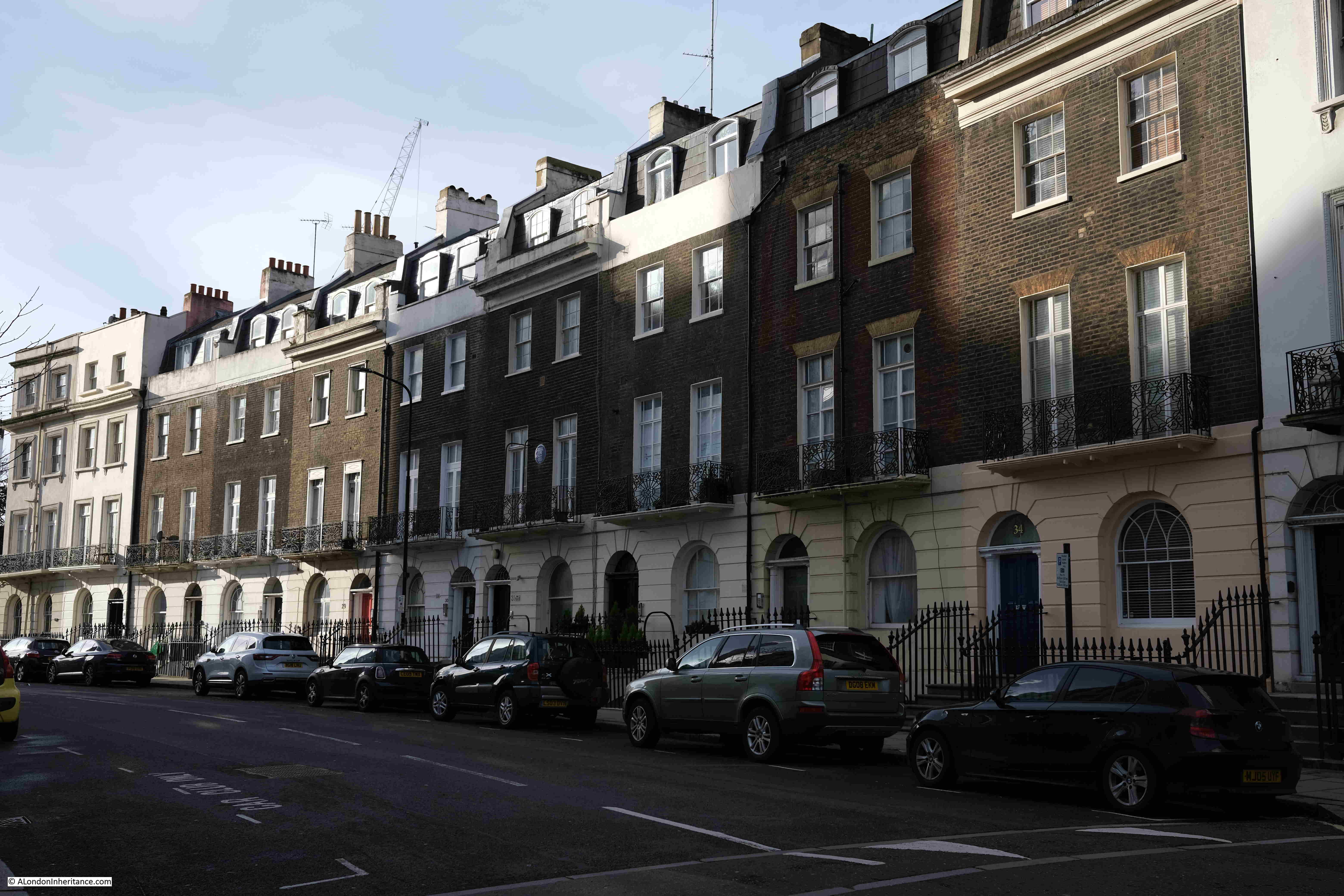
In the middle of the above terrace there is a blue plaque, to Spencer Frederick Gore, the painter, who lived in the building between 1909 and 1912.
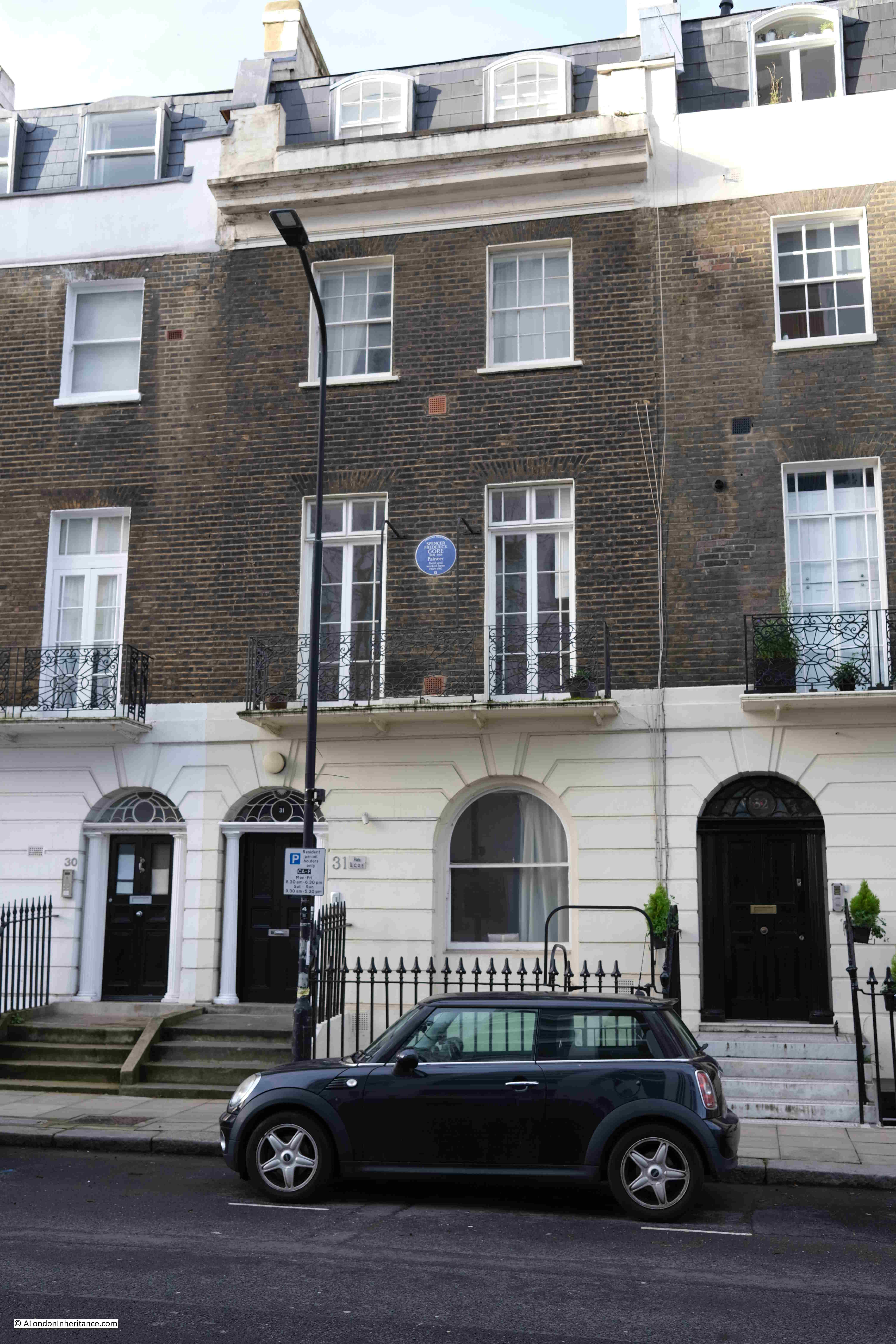
Gore painted the view from his house across the gardens and the view along Mornington Crescent. The Tate have one of his paintings of the gardens online here.
The following view is of the continuation of the terrace houses along Mornington Crescent, at the junction with Mornington Place:

Construction of Mornington Crescent started in the early 1820s and was not complete until the 1830s. It is named after Richard Colley Wellesley, the Earl of Mornington and Governor-General of India. He was also the eldest brother of the Duke of Wellington, so was from an influential family.
Mornington Place heads up to the rail tracks to and from Euston Station:

The street was built around the same time as Mornington Crescent and comprises smaller three storey terrace houses, although with some interesting architectural differences:
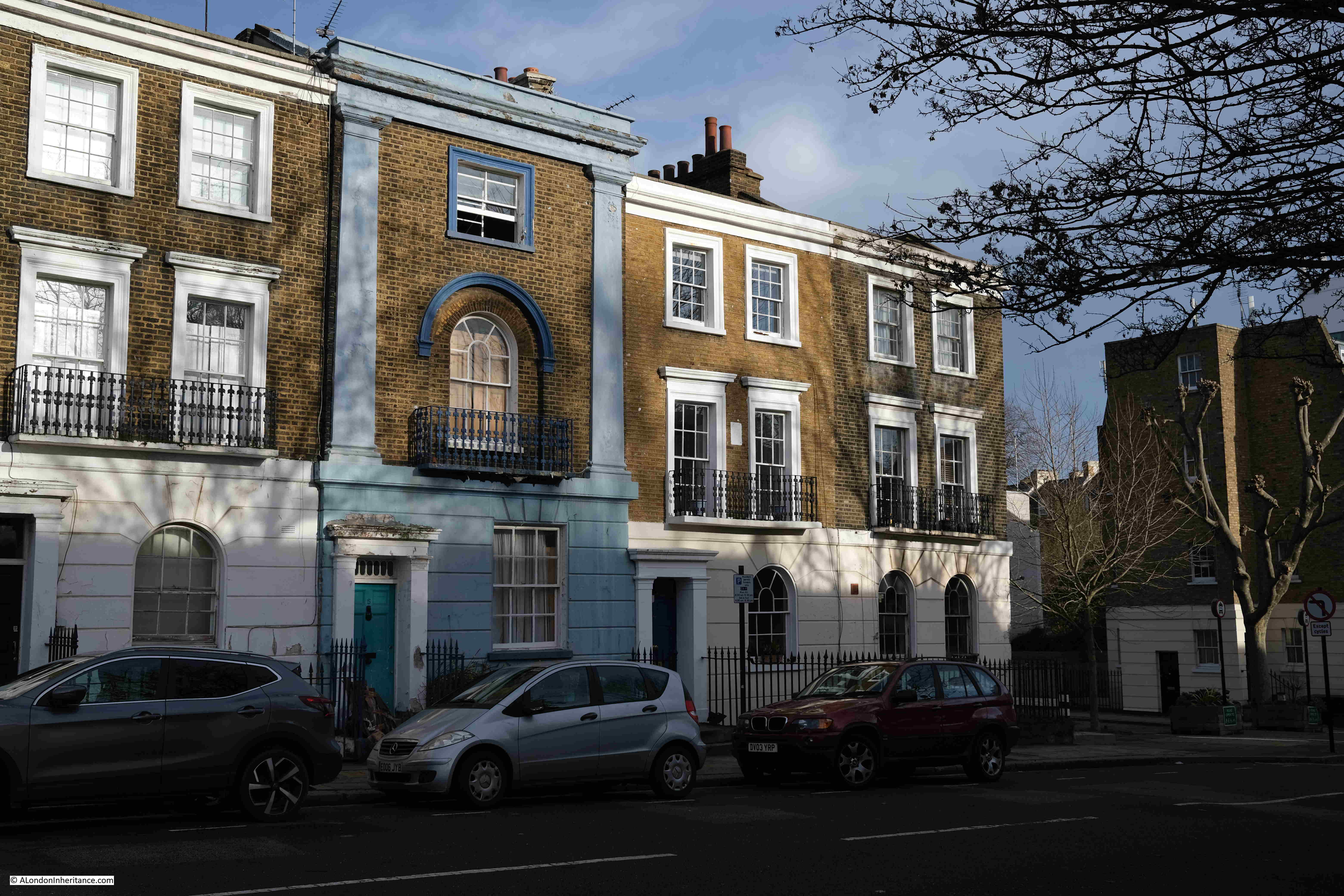
At the end of the street, we can look over the brick wall and see the rail tracks, with HS2 works continuing on the far side:
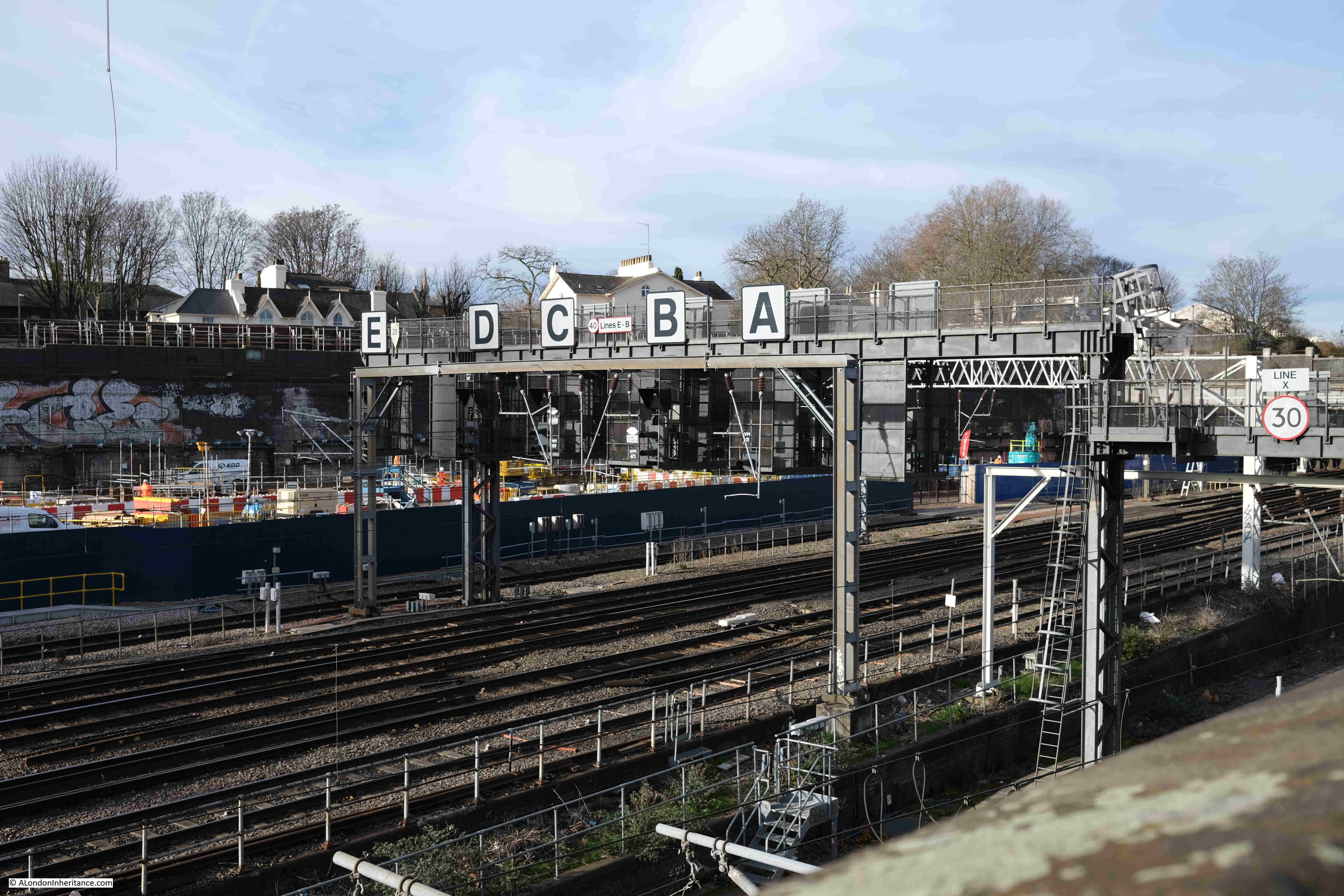
Looking back down Mornington Place towards the old Carreras factory – originally this view would have had the gardens at the end, through which Hampstead Road would have been seen:
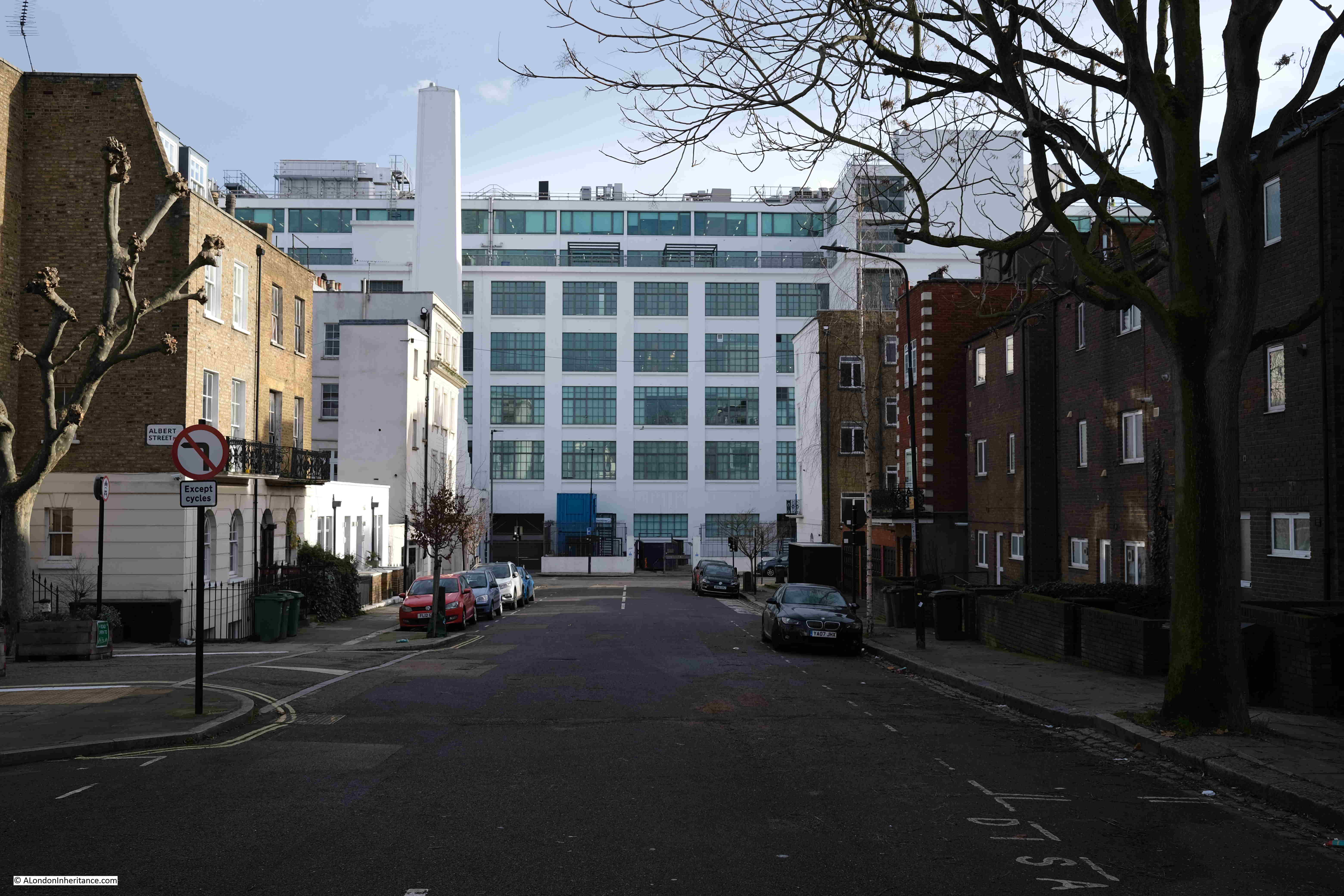
Albert Street is a turning off Mornington Place, a terrace of new buildings occupies a space which on the 1894 OS map appears to have been an open space with a larger building set back from the road.

There is a smaller brick building between the modern terrace and the large brick terrace of houses. This is Tudor Lodge:

Tudor Lodge is Grade II listed. It was built between 1843 and 1844 for the painter Charles Lucy, and believed to be to his own design. The plaque on the building though is to George Macdonald, Story Teller, who lived in the building between 1860 and 1863. An interesting building in a street of mainly 19th century terrace houses.
Rather than walk along Albert Street, I returned to Mornington Crescent and the rear of the Carreras factory, where there is a chimney:
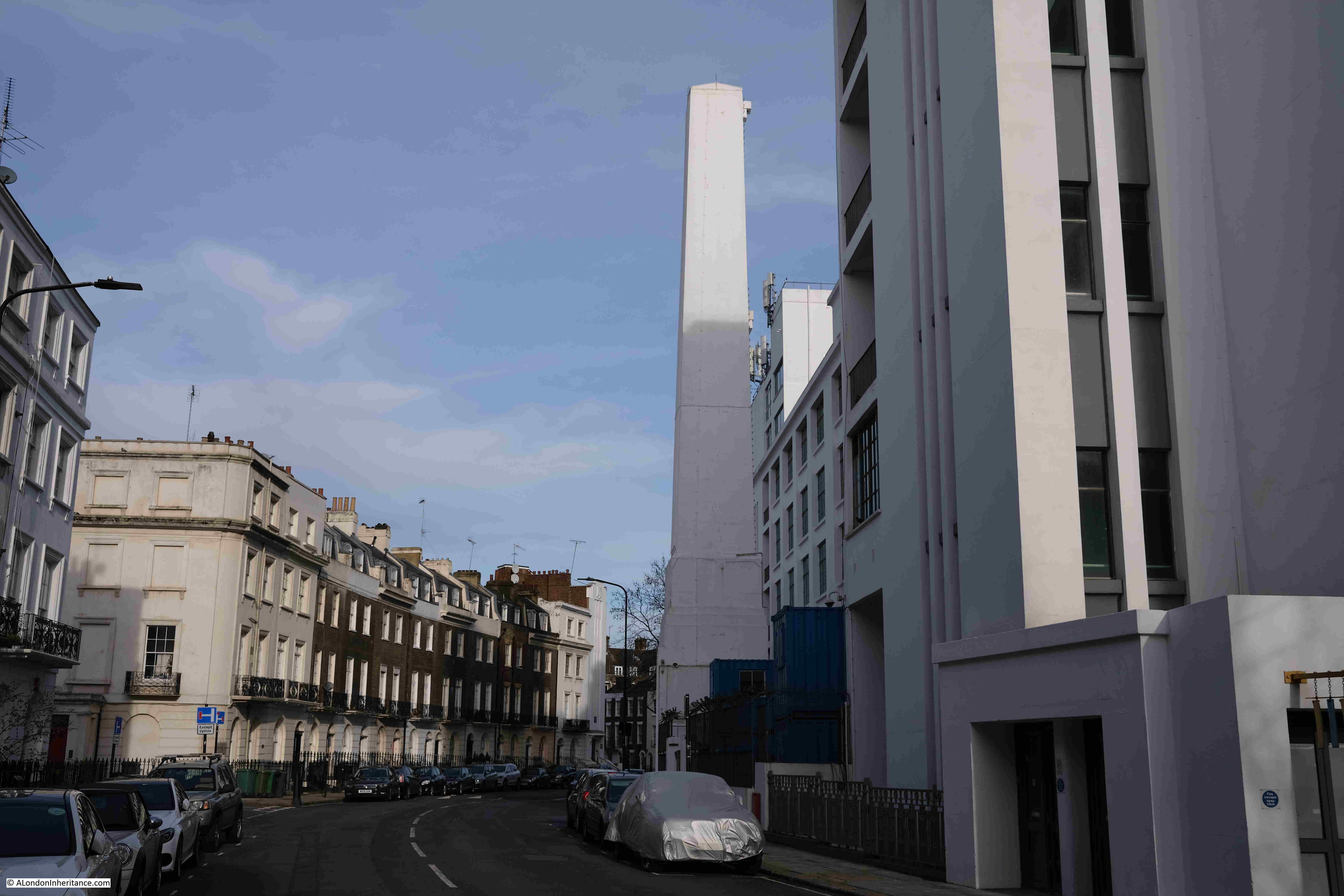
I have not been able to confirm whether or not the chimney is original, however rather than being the more common round chimney it seems to have the appearance of an obelisk, similar to Cleopatra’s Needle on the Embankment, so if original, the chimney continues the Egyptian design theme of the building.
Almost at the end of Mornington Crescent now, and the final row of terrace houses before reaching the Hampstead Road. The following photo gives an indication of the changes to the outlook of the houses when the Carreras factory was built. Rather than looking out on the gardens and across to Hampstead Road, they now had the view of the rear of the large factory.
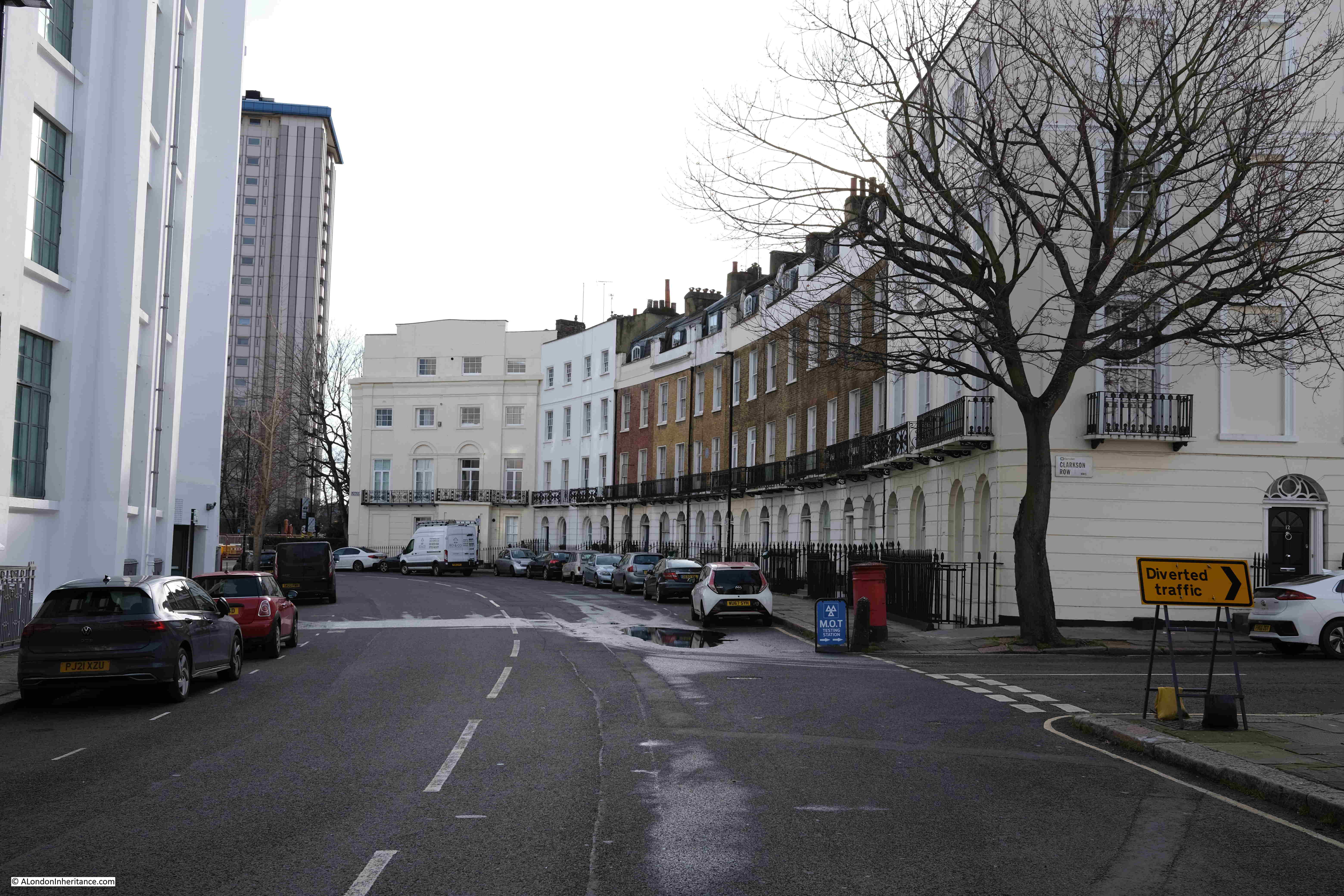
By the time the factory was built, many of the houses were almost 100 years old, and their condition was not that good, many were subdivided into flats. Their condition would deteriorate further during the 20th century, there was some bomb damage along the terrace in the Second World War and it has only been in the last few decades that many of the houses have been restored.
In this final terrace of Mornington Crescent there is another blue plaque, to another artist, this to Walter Sickert, recorded as a painter and etcher:
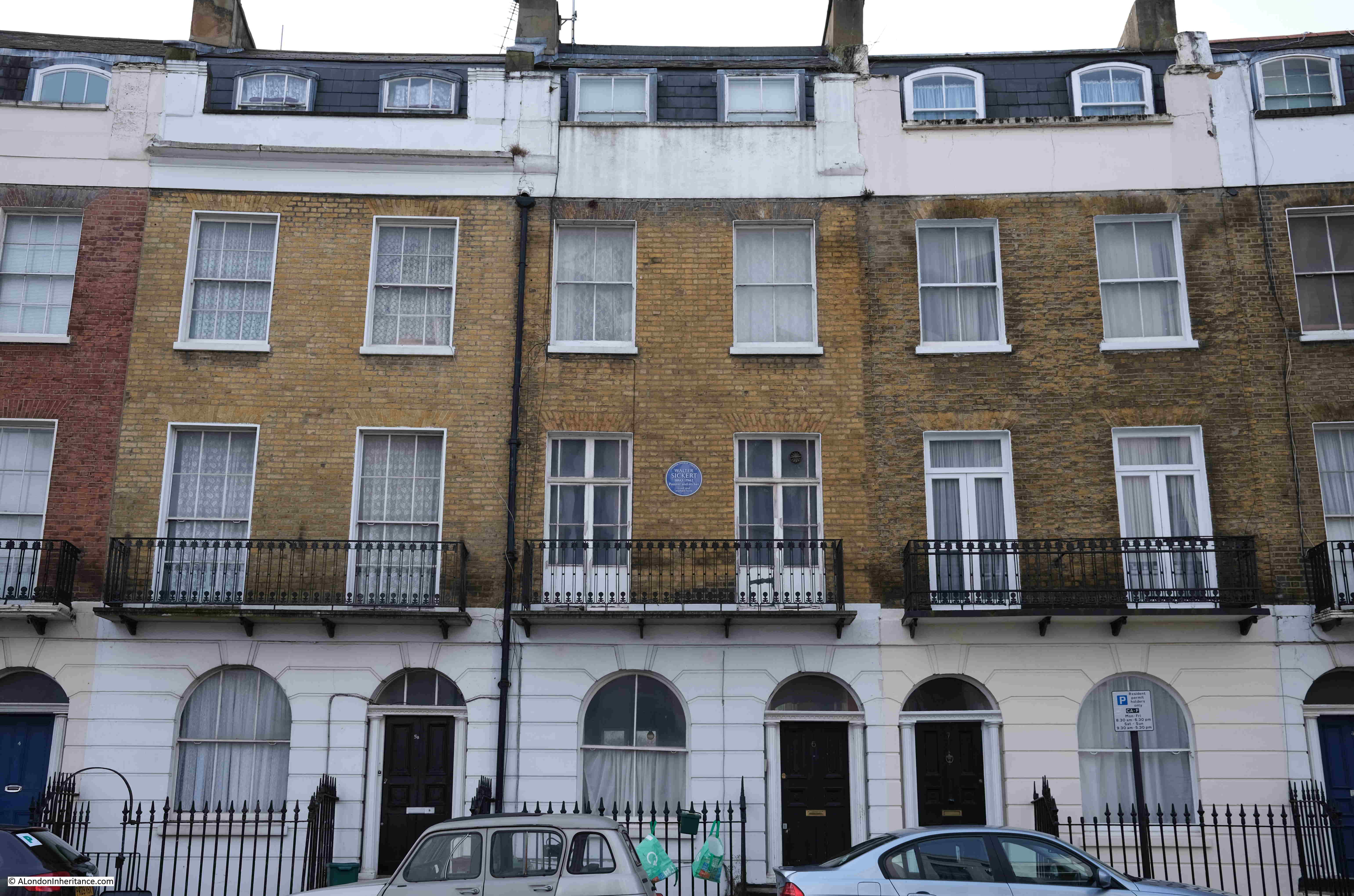
Sickert was at the core of the Camden Town Group of artists, a short lived group of artists who gathered mainly between 1911 and 1913.
The building at the southern end of Mornington Crescent, which has a Hampstead Road address is of a much more impressive design, presumably as it was at a more prominent position. Just seen on the wall behind the tree is another plaque:
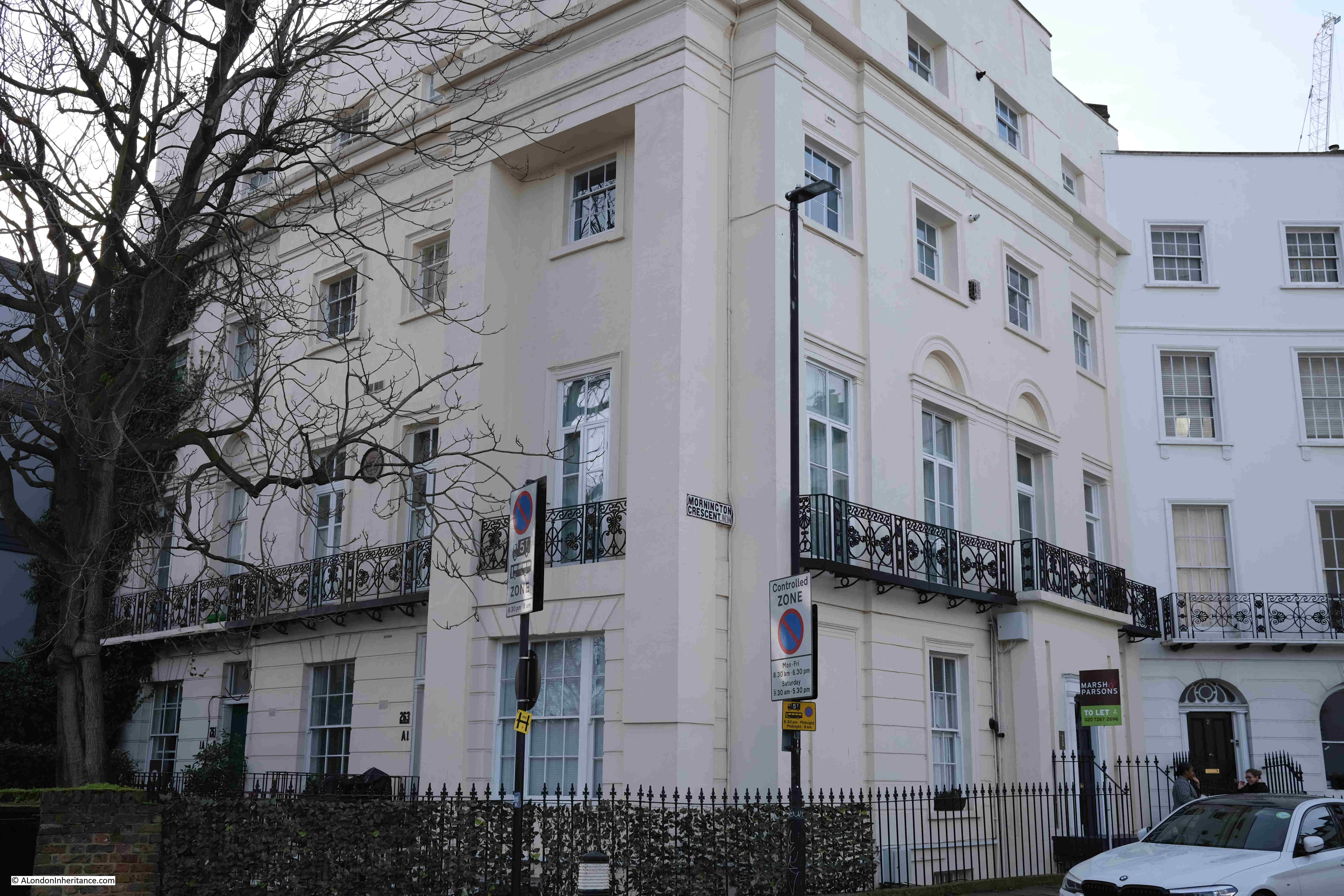
This plaque is to the artist George Cruikshank, who lived in the building from 1850 until his death in 1878.
On the opposite side of the street to the house in the above photo is a water trough for horses. I took a photo, but was not intending to include the photo in today’s post:

Until i found the following photo in the Imperial War Museum collection showing a horse and cart of the London, Midland and Scottish Railway pausing to drink at the trough, with Mornington Crescent in the background of the photo:

Pleased I found the photo, but rather frustrating as if I had found it before visiting I could have taken a similar view, however it does give a good impression of Mornington Crescent in 1943.
Returning to the space opposite the underground station, we can look south and get a view of the overall size of the Carreras factory, a building that occupied the site of the gardens between the crescent and Hampstead Road.

The space just to the north of Mornington Crescent underground station is the junction of Hampstead Road and Camden High Street, along with Crowndale Road and Eversholt Street.
To the east of the underground station at the road junction is the club / music venue Koko:

Originally the Camden Theatre when built in 1900, it then had a series of owners as both a theatre and a cinema, until 1945 when it was taken over by the BBC and used as a theatre to record radio programmes, including the Goon Show, with the very last Goon Show being recorded in the theatre on the 30th April 1972.
The BBC left in 1972, and from 1977 the building has been a live music venue, firstly as the Music Machine, then the Camden Palace and now Koko.
The building has hosted very many acts in its long history, including the Rolling Stones and the Faces, with my most recent visit to the Damned in February 2018 (and whilst researching the post I found a review of the Damned concert here).
The title of this post is Mornington Crescent and the Corn Laws, and it is only now that I can get to the final part of that title. In the open space opposite the underground station is a statue:
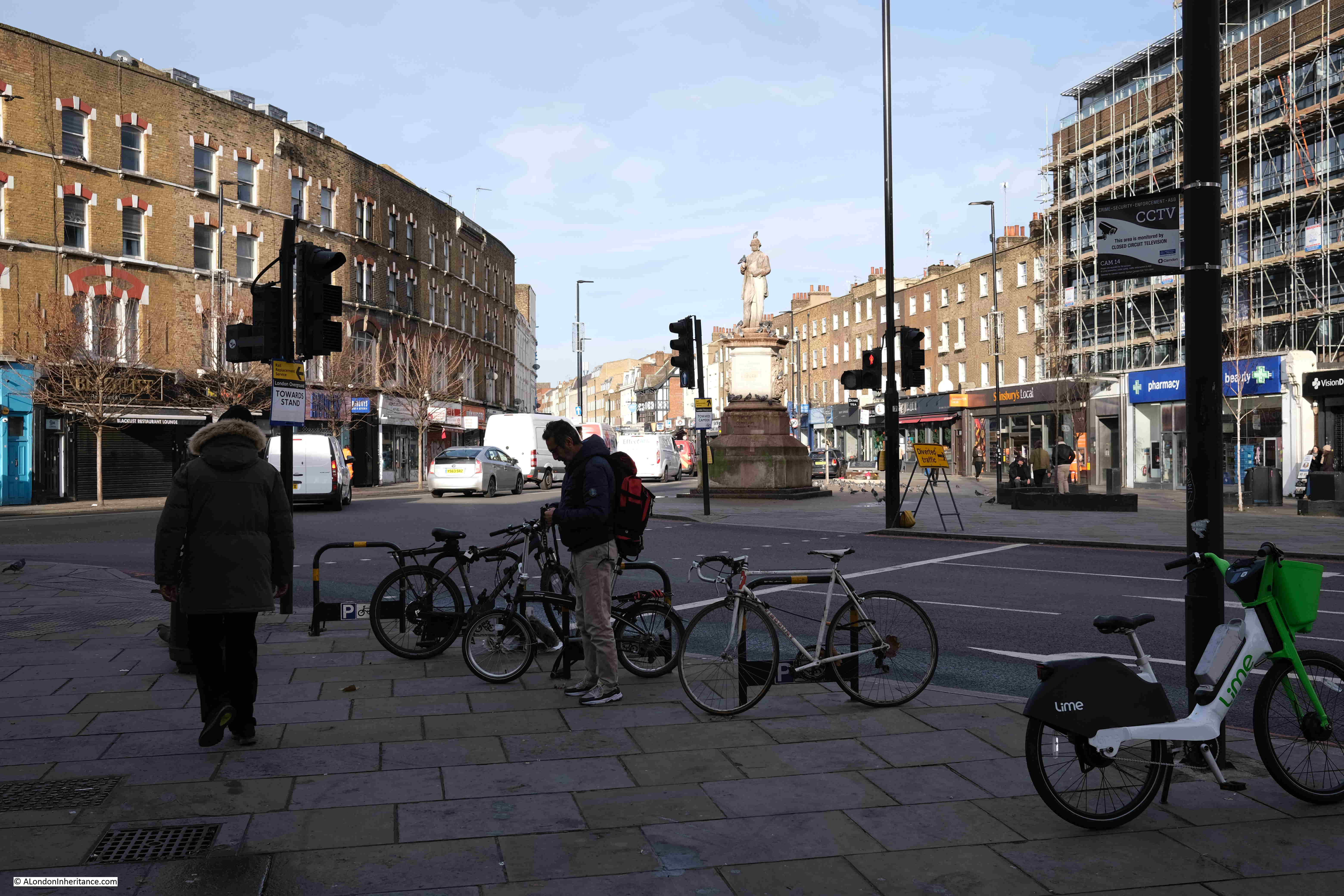
The statue is of Richard Cobden and was erected in 1868. Cobden did not have any direct relationship with Camden, however it was an impressive location for a statue, and it was put up due to the residents of Camden’s appreciation of Cobden’s work in the repeal of the Corn Laws.
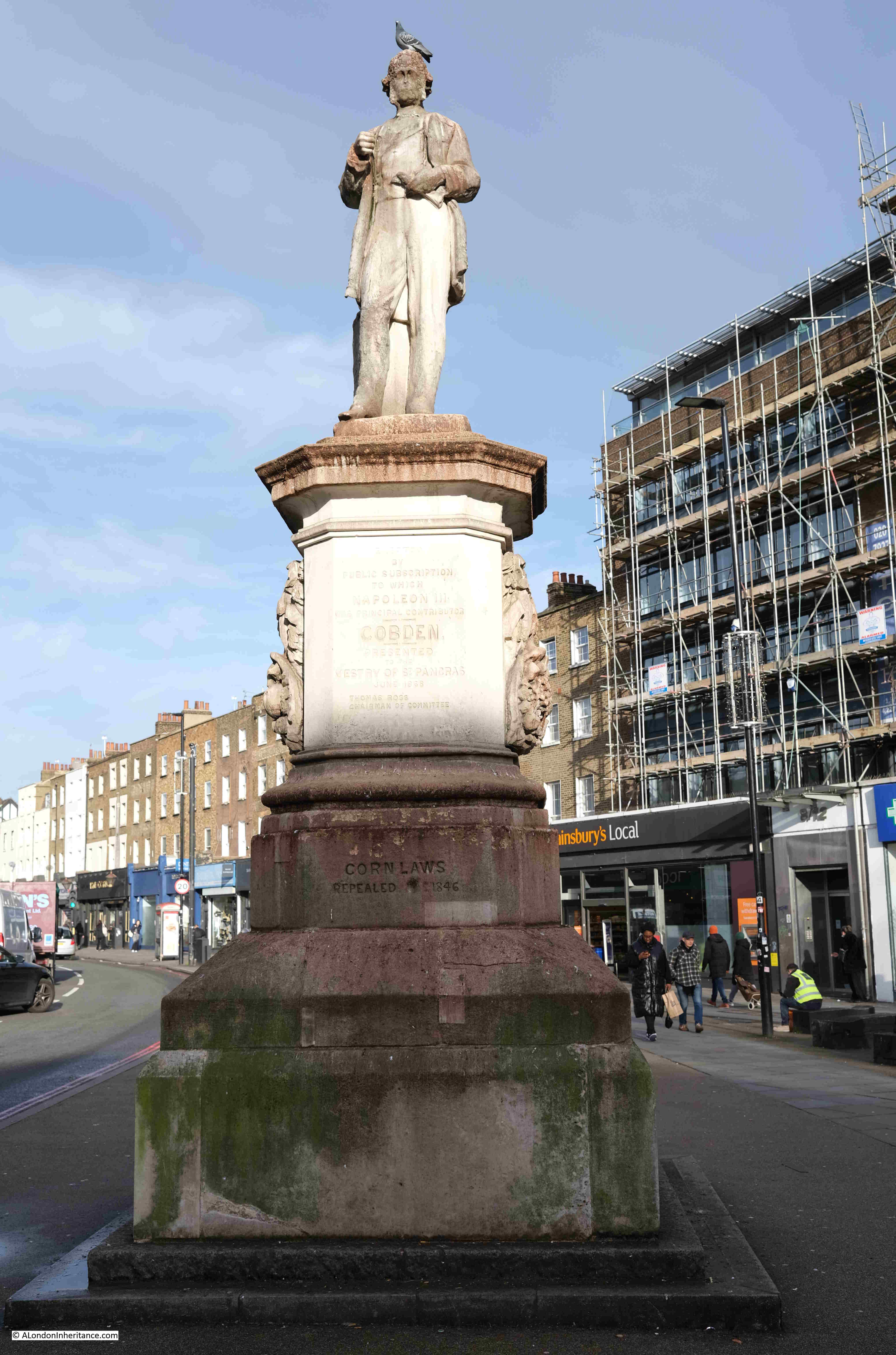
The Corn Laws were a set of laws implemented in 1815 by the Tory Prime Minister Lord Liverpool due to the difficult economic environment the country was in following the wars of the late 18th and early 19th century.
The Corn Laws imposed tariffs on imported grains and resulted in an increase in the price of grain, and products made using grain. These price increases made the Corn Laws very unpopular with the majority of the population, although large agricultural land owners were in favour as they made a higher profit from grain grown on their lands.
The Corn Laws were finally repealed by the Conservative Prime Minister Robert Peel in 1846, and they reflect a tension between free trade and tariffs on imports that can still be seen in politics today.
Richard Cobden was born on the 3rd of June, 1804 in a farmhouse in Dinford, near Midhurst in Sussex. His only time in London appears to have been after his father died, when Cobden was still young, and his was taken under the guardianship of his uncle who was a warehouseman in London.
Not long after he became a Commercial Traveler, and then started his own business which was based in Manchester, which seems to have been his base for the rest of his commercial success.
During his time in Manchester Cobden was part of the Anti-Corn Law League and was known as one of the leagues most active promoters.
The Clerkenwell News and London Times on the 1st of July 1868 recorded the unveiling of the statue:
“The Cobden memorial statue which has just been erected at the entrance to Camden Town was inaugurated on Saturday. Although this recognition of the services of the great Free Trade leader may have been looked upon in some quarters as merely local, the gathering together of some eight to ten thousand people to do honour to his memory cannot be regarded in any other light than that of a national ovation.
The committee had arranged that the statue of the late Richard Cobden at the entrance to Camden Town – with the exception, perhaps, of Trafalgar Square, one of the finest sites in London – should be unveiled on Saturday, that day being understood to be the appropriate one of the anniversary of the repeal of the Corn Laws, and the event was so popular that the surrounding neighbourhood was gaily decorated with flags for the occasion. The windows and balconies of Millbrook House, the residence of Mr. Claremont, facing the statue, had been placed at the disposal of Mrs. Cobden and her friends, including her three daughters.
A special platform had been created in front of the pedestal, covered with crimson cloth, and in the enclosure in front the band of the North Middlesex Rifles were stationed, and performed whilst the company assembled.
The report then covers at some length, all the speeches made which told the story of Cobden’s life and his actions in the repeal of the Corn Laws. There were many thousands present to witness the event, and at the end; “after the vast assembly had dispersed Mrs. Cobden, accompanied by Mr. Claremont, the churchwardens, and other friends, walked round the statue and expressed her high gratification at the fidelity of the likeness.”
The statue was the work of the sculptors W. and T. Willis of Euston Road, and is now Grade II listed.
I suspect if you turn right out of the entrance to Mornington Crescent underground station, you will be surprised to know that the space in front of you was compared to Trafalgar Square as one of the finest sites in London.
It always fascinates me how much history there is at almost any place in London, and Mornington Crescent is no exception. Whether the arrival of the underground, the architecture of the Carreras factory, race course gangs at the pub, historic streets, entertainment venues and radio shows and the statue of a free trade advocate – all within a short walk of Mornington Crescent.

A great read as always. Thank you, Mike.
Yes, a great read.
As for the Carreras factory cats, I’m sure they used the name Black Cat for one of their cigarette brands.
Yes
One of their adverts here – https://www.historyworld.co.uk/advert.php?id=156&offset=50&sort=0&l1=tobacco&l2=
The reference to a number of artists reminded me of
Frank Auerbach’s long association with Mornington
Crescent both as an owner of a studio very close by and for his many striking paintings of the Crescent itself. Well worth checking out images of his work.
A very informative article a great read, thank you.
Valerie
During the 1950s and 60s the Marchi Zeller wholesale bakery stood on Carlow Street. Nuns from a nearby convent used to call in for any leftover loaves, the bakers always made sure that there was fresh bread to spare for the sisters.
My first job in London was at the advertising offices of Thomson Regional Newspapers ( the Scotsman, Belfast Telegraph, Cardiff Western Mail etc) in GLH as it was known. Very old fashioned working practices – a seperate canteen for managers I recall and being made to attend religious services at the nearby church at Christmas. Still it launched me on a 30 year career.
I worked behind the bar at The Spread Eagle on Albert street- where I lived in a tiny flat – to supplement my 1500 pound salary!
I remember the factory when it was in operation. The brand of cigarettes was ‘Craven A’.
The last audience I had just adored me,
The reception I got was sublime
They made me a present
Of Mornington Crescent
They threw it a brick at a time.
Refrain from old music hall song — perhaps less than perfectly remembered.
Julie Andrews lived in Mornington Crescent during the war ‘Julie’s surname was legally changed to Andrews when she went to live with her mother and stepfather in Mornington Crescent, London, in the middle of the war. The family was poor then, and nowadays, when she describes the area, she makes no concessions to her fans who may live there. “It was a miserable spot,” she says.
There is more information on the park and building here: https://www.locallocalhistory.co.uk/ctown/p100/pages101-109.htm
Thank you, so interesting and informative.
There is another statue of Cobden (of a different design) in Stockport, where he was MP for a while. He was also a strong anti-slavery campaigner.
Better than the game! A great post.
Many thanks for a superb Sunday read. Richard Cobden was born in Dunford, near Midhurst. He rebuilt the family farmhouse in 1848 and it is now a superb grade 2 listed country house. Unfortunately now subject to many planning applications which have all been refused.
Thank you so very much for all the information and detail. It brings it all back to life and it is very much appreciated to be able to imagine as it used to be.
Thanks for this fascinating blog David. I often start guided walks at Mornington Crescent station and I point out that Emperor Napoleon III was the main contributor to the Cobden statue. The Repeal of the Corn Laws opened the British market to French grain and so clearly Napoleon would have wanted to make a major contribution to a statue honouring the main politician behind the repeal campaign. I put this within the context of the radical tradition of this area – naturally Camdenites would have wanted to commemorate a piece of legislation that struck a blow against the political dominance of the landed aristocracy.
What a great post. On the side of the water trough is written “Metropolitan Drinking Fountain and Cattle Trough Association” A real present day link to the past. Wonder how many others have survived ?
A great post, thanks. I wonder how many other ‘monumental’ factories survive? The not dissimilar K-L-G spark plug factory was a major landmark on the A3 at Roehampton; now the site is an Asda, I believe.
Thanks for another very interesting post which brought back many memories..
In the ’60s when I worked in central London I used to wait at the bus stop immediately outside that factory every evening for the 29 bus to take me home. I often wondered why there was Egyrtion style lettering on that building. I never realised how much history there was nearby.
Not sure if it comes from urban mythology, but i do recall someone on the radio (probably Robert Elms’ show) saying that the factory’s architecture was much admired by Hitler and was one of many London landmarks he intended to re-purpose when he eventually arrived victorious in London. There was also a suggestion that the Luftwaffe had instructions to avoid destroying his ‘favourite’ London landmarks. Sounds absurd but who knows?
It is said that Oxford was not bombed as he intended to make it the seat of government !
George Cruickshank also lived in another house a few streets away from Mornington Crescent with his mistress Adelaide, who had been his wife’s maid, and their eleven children. When Adelaide fell pregnant she refused to say who the father was and she was dismissed so Cruickshank set her up in another property, and they were known as Mr and Mrs Archebold.
When Cruickshank was dying he asked “what will happen to my children?”. After his death Mrs Cruickshank made enquiries and selflessly supported her husband’s family.
Fascinating insights into one of my favourite buildings in London. Thank you David
Utterly fascinating. I was there the other day, but will return to tour the area.
As usual, a great post. My mother was born in October 1928 just before it opened. The two of us did a lot of London exploring together. I remember she told me that her parents thought this building was hideous!
The black cats at the entrance to the Carreras factory are significant as ‘Black Cat’ was a brand of cigarette made by Carreras. Fascinating post.
My first visit here. Those black cats; I knew the building (early 1970s) as the Black Cat Factory. Black Cat being a brand of cigarrette by Craven.
I worked briefly in Greater London House in the early 2000s, just after it had been refurbished. It was palatial compared to my previous workplaces, even if it was invariably quicker to take the stairs, all 131 of them, than the lift to my desk on the 5th floor.
Mornington Crescent station was built as part of the Charing Cross, Euston and Hampstead Railway, and opened on the 22nd of June 1907. The station is one of Leslie Green’s distinctive station designs with the exterior walls covered in red oxblood faience tiles. The station is now on the Northern Line.
The station of course has not moved 🙂
I had known that it came close to being closed permanently but not of the more detailed history …. and the plaque to Willie – see below. But as always, a fascinating excursion with you, in an area I have occasionally wandered around, before and after skippering or crewing trips for the Pirate Castle, or activities at the Third Age Project Cumberland Market. There – a few more to explore for you 🙂
https://en.wikipedia.org/wiki/Mornington_Crescent_tube_station
The entrance to Mornington Crescent Underground was moved to the Hampstead Road side of the building. I originally faced Richard Cobden’s statue, with a chemist to its right and another small shop as part of its entrance. Outside was a newspaper seller who stood there in all weathers.
At the rear of the Carrera’s building there was a very large cat’s head which we children would try to touch – it was very low down on the wall. It’s not there now. By coincidence, I now work in the building, but I remember the smell of tobacco from the factory when I was a small child.
Enjoyed reading your post! Thank you for engaging commentary!
Thank you for another fascinating post with some great photographs. You bring the history of this most magical of cities alive.
Most excellent! Look Up London and IanVisits have posted in the past about the factory building, and this provides a great deal of additional background, particularly about the area. As always, thank you.
Thanks for another fascinating post.
In my youth, I can remember smoking Black Cat cigarettes. They were pretty awful. Craven A also had a black cat on the packet.
Black Cat registered trade mark ‘Craven A’ cigarettes …… When I went to stay with French family friends (i.e. they were friends of the French cousins) in Paris over Christmas c. 1970 M. Lebouche asked about these, which he’d known from I guess WWII and after …
http://letslookagain.com/tag/craven-a-history/
And more pix etc., of the factory are at https://jannaludlow.co.uk/Art_Deco/Black_Cat_Factory_info.html
In the mid to late 70s I worked for a design company in Hatton Garden, and often had to visit our client Thomson Holidays (possibly related to Thomson Newspapers mentioned above?) in Greater London House. The connections made then reverberate through my career / life to this day.
Interested to read about the unveiling of the Cobden Statue. Walter Sickert married Richard Cobden’s daughter Ellen (Nellie) in 1885. There is a website about Dunford House and the planning issues at: http://www.cobdenfoundation.org
How interesting. Like David Holmes who has also commented, I used to visit the building when I worked at the Leo Burnett advertising agency for meetings with my client Thomson Holidays. I also had a job interview at Young & Rubicam the ad agency who had offices there and was surprised when I got out of the lift at their floor to discover all the walls in reception were covered in carpet. My wife worked for a design company owned by Y & R also located in the building. So many connections. Thanks for this great post
I’ve seen that statue many times and often wondered who it commemorated and why so thanks for all that information.
Mornington Crescent station also features in the first few Bryant And May books by Christopher Fowler, where the upstairs of the station is the headquarters of the Peculiar Crimes Unit. A very entertaining London-based series of books.
https://www.bookseriesinorder.com/bryant-may/
Some time ago I searched for online images of the Carreras factory interior and found none. I was surprised.
Great stuff
Interesting comment that the Carreras factory was an improvement on the “dirty” gardens. My immigrant factory moved to Mornington Crescent in the 1920s and suddenly instead of greenery they looked out onto the ugly concrete back of the factory, not to mention the noise, pollution and delivery vehicles. The front was dressed up in mock Egyptian/Art Deco style which had nothing to do with the production of Baron’s “pure Virginian” cancer sticks appropriately named Craven A and Black Cat. The Crescent had belonged to the Earl of Southampton’s estate which sold the 3 acre gardens to the cigarette company to make money. Planning control was minimal and no doubt official corruption was involved. “Various societies” objected to the building but were dismissed. “The adjoining property owners have in no way been violated” The usual justification that local jobs would be affected if Baron was not allowed to build where he liked was trotted out. The 60s restoration should have involved the demolition of the factory and the reinstatement of the gardens.
It’s always a tricky problem working out how far time could be turned back. When the crescent was first built it was pretty up market, but by the time of the factory building it was notoriously run down and payments for the maintenance of the privately owned garden had been uncollectable for decades due to the subdivision of the houses into seperate rooms to be sublet. Admittedly living there whilst the construction work was going on must have been pretty miserable, but we ended up with a truly iconic and unique building.
Ironically, without the building there pollution and noise would be far worse as the factory acts as a substantial barrier between the crescent and the very busy Hampstead Road.
Of course the crescent had been run down by the estate landlords and was now full of poor tenants like my family who had no rights, thus they had no say in the proposals to fill the neglected gardens with a lumpen factory and property developers at the time could run roughshod over any objections from environment groups. The notion that the factory provided a barrier from the pollution of Hampstead Road traffic is pure nonsense, planting more trees would have been a far better solution. I wonder how many employees developed cancer as a result of working with tobacco. I recognise that we can’t put the clock back, but is the notion of the rich imposing their will on the less fortunate any different today?